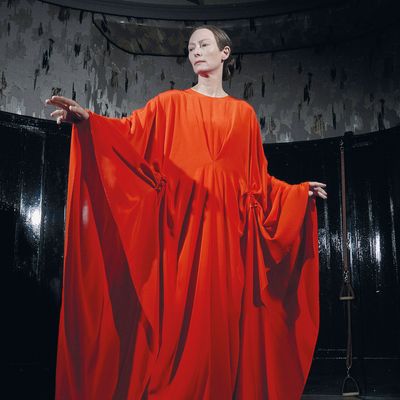
This review originally ran during the Venice Film Festival.
I know this isn’t cool and perhaps pointless to say, but I wish a woman had remade Suspiria. Let me unpack that. One: I wish a woman had been empowered and/or inspired to take a crack at Dario Argento’s iconic but deeply flawed witch tale. But I love Luca Guadagnino’s grotesque, political, radically feminine (feminist? We’ll get to that later) interpretation, and it’s not at all accurate to say that I wish the job had gone to another filmmaker. And so, two: I wish that more female filmmakers were making this kind of work at this level, tales that go beyond simple empowerment and voice-giving and live in the chaotic, ambiguous, messy and biological realm that should be the antithesis of patriarchal cinema. Suspiria had me thinking more than a few times of Paul Verhoeven’s Elle, one of the best, most psychologically complex and uncompromising films about sexual assault in recent years, another film by a man. As with Verhoeven’s film, none of what Suspiria arrives at is comfortable, and I wish there were more stories about women by women that were emboldened to be this unsettling.
What Luca does, and frankly, what Suspiria deserves, is to turn the tale of a coven of witches who lord over an unholy dance academy in Berlin inside out. What was a pretty goal-oriented game of “escape the of old crones” becomes something more impressionistic about the absurd violence of being a woman. Just as in the original, it begins with Susie Bannion’s (Dakota Johnson) auspicious arrival at the Markos Dance Academy, and the unraveling of Patricia Hingle (Chloe Grace Moretz.) But screenwriter David Kajganich digs deeper into almost every aspect of Argento’s original, particularly Susie’s American origins, and the setting of Berlin during the “German Autumn” of 1977, when the Baader-Meinhof Group was perpetrating terrorist acts all over the city. The mess of divided Berlin and the horrors of the Third Reich haunt the school, ruled over by artistic director Madame Blanc (Tilda Swinton) and the seldom seen grand dame Helena Markos. Their institution could be seen as a kind of counterbalance, a fortress against the ugliness that Berlin has seen, a beacon of hope through art and expression and physical integrity.
But it’s clear from the outset that a deeper violence lives in its walls, and it’s driven Patricia mad, confiding in her analyst Dr. Josef Klemperer (“Lutz Ebersdorf,” but quite obviously Swinton under layers of convincing prosthetics.) The elderly Josef spends much of the movie investigating the strangeness of Patricia’s claims, and her subsequent disappearance (explained away by her involvement with the radicals.) But he’s a faithful Jungian, and convinced that all her fantastical claims of witches and magic can be explained through rational analysis.
There’s a cutting, brutal answer to his quest late in the film. But in the meantime, Susie’s star quickly rises at the school, attracting the attention of Madame Blanc and the staff, and she is groomed as a tool of ambiguous occult ends. Blanc imbues her hands and feet with some unexplained glowing energy and has her dance the lead in a piece the group has been working on. As she goes through the violent, ecstatic movements (choreographed with unsettling intensity by Damien Jalet), in another room, the body of fellow student Olga (Elena Fokina) who has lost favor with the instructors, is twisted and warped in bone-breaking agony, chained to Susie’s movements like a rag doll. It’s an unbearably gruesome, violent sequence; Susie’s ravishing choreography intercut with Olga’s screams, set to Thom Yorke’s thrumming score.
Some may not make it through that sequence. Those who do will see the follow-up meeting between Blanc and Susie, in which they inexplicably nibble on chicken wings and Susie, still oblivious to the torture she enabled, says the dance felt “like what it must feel like to fuck.” It’s a crazy line, and jarringly out of place in what is an almost entirely sexless film. There is no lust in Suspiria, so often an easy chaser for violence in the horror genre. The Berlin winter is cold and bloodless, the bodies of the dancers are not objectified for our titillation, never lovingly panned over in bloody death. They are terrifying houses of horror, and only get more terrifying as Susie goes deeper down the coven’s rabbit hole.
Here’s where I anticipate Guadagnino might get accused of making an anti-woman film, of presenting the dancers’ and witches’ bodies and their collective energy as something to be dreaded and cursed. But what is the alternative, in the world of the film? Madame Blanc has the dancers prepare a performance of a piece entitled Volk, which she originally choreographed in the aftermath of World War II. When Susie, weary of its demanding leaps, suggests an alteration to it, Blanc bears down on her, livid, assuring her there’s no way for her to understand the place and time and devastation it was born out of. She then has Susie run through the jumps, over and over again, in a movement whose exhausting repetition starts to resemble a kind of warding off spell, an insistent fight against gravity. Dance, an extension and tool of the coven’s witchcraft, is a fortress against the other evils of the world. That doesn’t mean that everything within its walls is pretty, or peaceable, or good. And Susie’s path is not a hero’s journey; she’s not there to anything so patriarchal as conquer an enemy or “find herself.” Guadagnino’s vision does not allow for anything so seductive or comforting as that. Suspiria is a gorgeous, hideous, uncompromising film, and while it seeks to do many things, settling our minds about the brutality of the past and human nature is not one of them.

